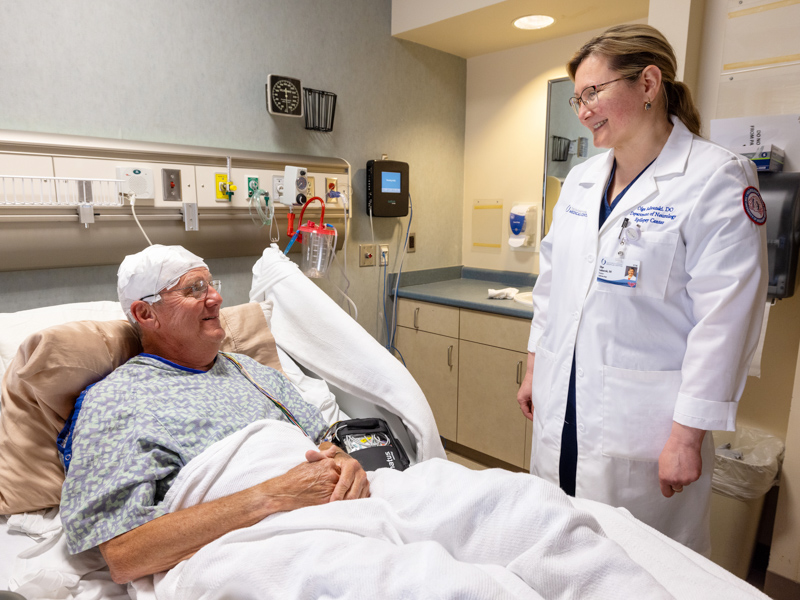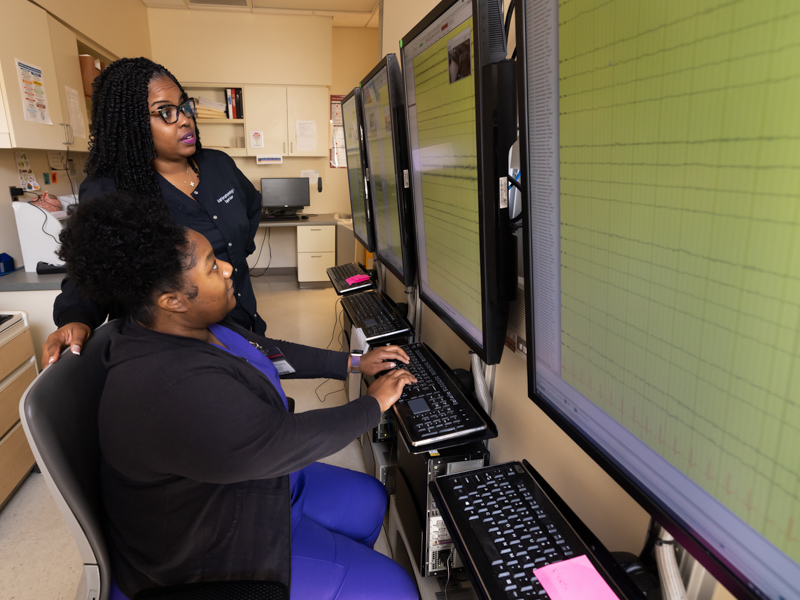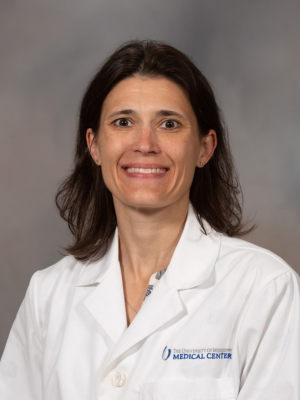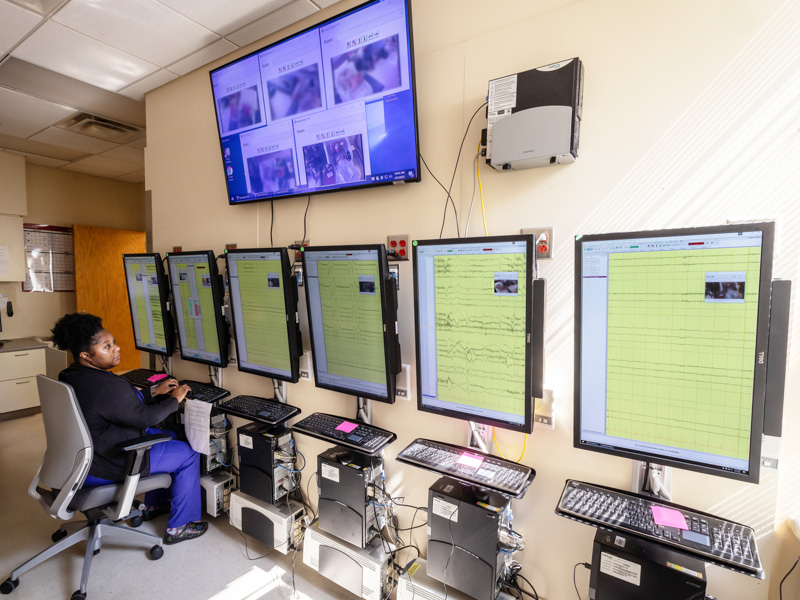Unique inpatient program captures patients’ seizures to speed diagnosis

Although having what seemed like multiple seizures a day was wearing him out, William Moore wanted – and needed – to keep them coming.
In a hospital bed and continuously hooked up to an EEG in the Epilepsy Monitoring Unit at the University of Mississippi Medical Center, the Raymond resident waited to have a spell or event so that it could be viewed, recorded and analyzed. That will give him and his providers critical information on what’s been going wrong.
“I’d been having four or five seizures a day, and then I was put on Keppra and it went down to zero about eight days ago,” Moore said of the events that began in 2018, but had not been definitively diagnosed as a seizure disorder.

The only one of its kind in Mississippi, the Epilepsy Monitoring Unit, or EMU, is an inpatient program that provides 24/7 monitoring of patients with a known seizure disorder that needs further study, or who are experiencing episodes that have seizure-like symptoms.
The goal: Rule in or out whether patients have a seizure disorder, and if they don’t, use information gleaned from their stay to look for a diagnosis. Data is used to better categorize and treat the patient’s seizure disorder, whether that’s through medications or surgery.
Patients have continuous EEGs and EKGs over a stay of several days, said Skyla Wilson, neurophysiology laboratory supervisor in the Department of Neurology.

“If we can capture the event, we can find out very quickly what’s going on,” said Dr. Alissa Willis, professor and chair of the Department of Neurology.

And if a patient is found to have received an earlier epilepsy misdiagnosis, they can immediately be taken off seizure medications that can harm them, said Dr. Sameer Sharma, assistant professor of neurology and medical director of the Neuroscience ICU.
How long the patient stays varies according to the severity of their disease and how long it takes to have episodes or seizures. “Once their doctor feels they have enough data, they are put back on their medications and prepared for discharge,” Wilson said.
Since being admitted on a Tuesday, Moore’s every move was being watched by team members including Yvette McClendon, a neurodiagnostic assistant. McClendon sat at a desk in a room down the fourth-floor hall with a large video monitor mounted on a wall with windows bearing a stream for each bed in the adult unit. She watched and listened for signs that Moore and the other five patients were about to have, or were having, a seizure.
In the room next door, neurophysiology technologist Tara Mays used her computer to analyze and document the constant stream of data.
Each patient’s EEG is continuously in action on a screen directly below the monitor. There’s a treasure trove of information. An intercom system in each room allows McClendon and others to listen in and talk to patients.
The six adult beds and four pediatric beds stay full, and there’s a waiting list, Wilson said.

Patients having suspected or known seizures typically check in at the EMU on a Monday morning, and if they’re on a seizure medication, it’s stopped. The neurology team prefers the patient have multiple seizures or events over a few days in the EMU, one reason why 24/7 monitoring is critical.
There are no cameras in bathrooms. Patients are not allowed to take a shower due to wearing EEG leads, and “we also don’t want them in the shower and to have an event, and we can’t see it and get to them right away,” Wilson said.
But, they can read or use their laptop computers, and they can bring their own pajamas and other personal items from home. “We try to create the most normal environment possible,” Wilson said.
When a patient feels a seizure or event coming on, they push a button, if they’re able, to alert the person monitoring them. Providers can immediately respond to their room because some seizures can be serious.
“Seizures are different. I see grand mal seizures. I’ve seen some people get combative,” McClendon said. “I’ve seen them go into a deep sleep, or wake up screaming. I see their behaviors change when they’re on and off their medicine.
“Some people tell me they feel like they have a carousel in their head, or that they smell something burning. One woman told me that pizza and wine trigger her seizures, and she was right.”
In Moore’s case, since 2018 he’s smelled a chemical odor right before he has a seizure. “Every time, I would smell that same smell,” he said. “They last about 15 seconds and aren’t debilitating, but it’s very weird.”
He had an MRI early on. It gave no answers. But recently, he saw Dr. Chad Washington, chair of UMMC’s Department of Neurosurgery. “He did an MRI, and he saw a light-colored area on the right side of my brain,” Moore said. “That’s when we started investigating.”

The EMU gave Melanie Campbell Bowman the answers she needed when, with little or no warning, she would pass out and risk serious injury. “Mrs. Bowman was falling and hitting her head,” Willis said. “She had seen doctors in the community for several months, but couldn’t get an explanation for what was going on.
“They were happening so frequently that the family was very scared.”
After several days in the EMU, “Mrs. Bowman had an episode. We found that her heart was stopping for a few seconds at a time, and it was making her pass out,” Willis said.
Because Bowman was monitored at all times, “we could see her heart missing those beats,” said Sharma, Bowman’s neurologist. Blood flow to her brain was interrupted, causing her to become dizzy and faint. She was having both cardiac and neurological symptoms, Sharma said.
“That’s what gave us the diagnosis. It’s not uncommon for symptoms of this kind to bring a patient to a neurologist, because the presentation is mostly neurological.”
“The neurology team worked with our cardiology team. Mrs. Bowman got a pacemaker the next day and was discharged,” Willis said. “Because of the quick diagnosis and getting the pacemaker placed, we’ve prevented her from having severe complications and even death.”
Bowman, who divides her residency between Vicksburg and Greenwood, is feeling much better, and she and her family are relieved that she finally has a diagnosis and treatment. “The care was unbelievable. I had two teams,” she said. “They worked together and found that I needed a pacemaker. I’d never thought about a pacemaker.”
The EMU provides state-of-the-art treatment close to home, Willis said. Providers can make a direct referral to UMMC Neurosciences and the EMU by calling (601) 984-5500 and selecting option 1. “If we didn’t have the EMU, there would be a lot of either undiagnosed patients, or patients with a prolonged delay in diagnosis,” Sharma said.
Bowman “told me that she always thought she had to go to the Mayo Clinic or Cleveland Clinic to get good neuro or heart care,” Willis said. “She was shocked that she could get the same care right here in Mississippi.”
Two days after he was admitted, Moore still hadn’t had a seizure. But that day, three patients got to go home after having the several needed to produce data. “We’d like him to have one by tomorrow,” Wilson said.
For many, it’s worth the wait.
“If it was just one a day, it would be OK,” Moore said of his episodes. “But four or five a day … it’s exhausting me.”


